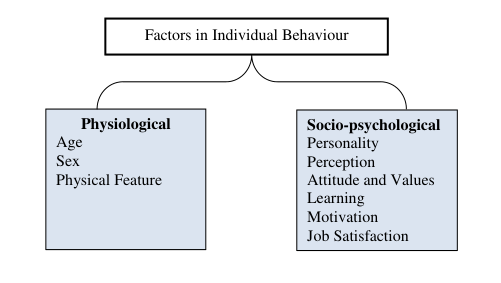Table of Contents
What is Individual Behavior?
Behavior is what a person does. Behavior is defined as the observable and measurable activity of human beings. This is known as overt behavior. Activities that qualify under this category show great variation; these may be in the form of mental processes like decision-making or physical process like handling a machine.
There is another aspect of behavior that is non-observable or measurable, known as covert behavior like feelings, attitude formation- favorable or unfavorable, perception formation, etc. Covert behavior is a significant part of total behavior because it shapes and influences overt behavior. Thus understanding the total behavior is important.
Foundations of Individual Behavior
Factors that affect an individual’s behavior may broadly be classified into two major categories:
- Physiological, and
- Socio-Psychological

It may be mentioned that physiological factors are biological and, therefore, they cannot be learned. Socio-psychological factors can be developed by an individual over a period of time through learning and practice.
Biographical Characteristics
Human beings possess certain biological endowments which are vital to their behavior. Various psychological characteristics of heredity, sensory organs, physical build-up, and the nervous system determine the outcome of the behavior. However, a person is not merely a conglomeration of organs, nerves, bones, and brain but a much more complex one.
Age
The importance of the relationship between age and job performance is increasing. It is tempting to assume that age is also inversely related to absenteeism. In general, older employees have lower rates of avoidable absence.
However, they have higher rates of unavoidable absence, probably due to their poorer health associated with aging and longer recovery periods when injured. There is a widespread belief that productivity declines with age and that individual skills decay over time. Reviews of the research find that age and job performance are unrelated. This seems to be true for almost all types of jobs, professional and nonprofessional.
Gender
There are few if any, important differences between men and women that will affect their job performance, including the areas of a. Problem-solving b. Analytical skills c. Competitive drive d. Motivation e. Sociability f. Learning ability There is no evidence indicating that an employee’s gender affects job satisfaction.
There is a difference between men and women in terms of preference for work schedules. Mothers of preschool children are more likely to prefer part-time work, flexible work schedules, and telecommuting in order to accommodate their family responsibilities. Women’s quit rates are similar to men’s. The research on absence consistently indicates that women have higher rates of absenteeism.
Marital Status
There are not enough studies to draw any conclusions about the effect of marital status on job productivity. Research consistently indicates that married employees have fewer absences, undergo fewer turnovers, and are more satisfied with their jobs than their unmarried co-workers. More research needs to be done on other statuses besides single or married, such as divorce, domestic partnering, etc.
Ability
We were not all created equal. Everyone has strengths and weaknesses in terms of ability in performing certain tasks or activities; the issue is about knowing how people differ in abilities and using that knowledge to increase performance.
Ability refers to an individual’s capacity to perform various tasks in a job. It is a current assessment of what one can do. Individual overall abilities are made up of two sets of factors: intellectual and physical.
The Ability-Job Fit
Employee performance is enhanced when there is a high ability-job fit. The specific intellectual or physical abilities required depend on the ability requirements of the job. For example, pilots need strong spatial- visualization abilities. Directing attention to only the employee’s abilities, or only the ability requirements of the job, ignores the fact that employee performance depends on the interaction of the two.
When the fit is poor, employees are likely to fail. When the ability-job fit is out of sync because the employee has abilities that far exceed the requirements of the job, performance is likely to be adequate, but there will be organizational inefficiencies and possible declines in employee satisfaction.
Abilities significantly above those required can also reduce the employee’s job satisfaction when the employee’s desire to use his or her abilities is particularly strong and is frustrated by the limitations of the job.
